Ovid ended Book 5 of his Metamorphoses with the Muses telling Minerva stories. He opens Book 6 with a story centred on Minerva which appears almost unique to Ovid (only Virgil precedes, mentioning it more in passing), and is peculiarly relevant to Ovid’s later banishment. Although relatively short, to my mind it is one of Ovid’s best stories, and told particularly skilfully with wonderful ecphrases.
The Story
Minerva is still reflecting on the stories of the Muses, when it occurs to her that she should be praised, not despised, and this leads to the story of the fate of Arachne.
Arachne was famous for her wool-craft. She had been born into a humble family: her mother had died when she was young, and her father dyed wool using Phocaean (Tyrian) purple. She became known throughout Lydia for her spinning, weaving, and embroidery in wool. When it was suggested that Minerva had taught her, she denied it and put out a challenge to the goddess to show who was the better weaver.
Minerva disguised herself as a frail old woman and spoke to Arachne, suggesting that she should apologise to the goddess. But Arachne was not swayed, and called on Minerva to rise to her challenge. At that point, Minerva revealed herself, and Arachne still showed neither fear nor contrition.
Without delay, the two women set up their looms ready to weave. They girdled their robes tight below their breasts, and started weaving at a furious pace. Minerva weaved an image of the twelve major gods on their thrones, with miniatures in each corner, and an olive branch winding around its edges.
Arachne’s woven images were less flattering to the gods. They included the rape of Europa, Leda and the swan, the rapes of Antiope, Danae, Mnemosyne, and of Proserpine. She also portrayed the deceptions of other gods including Phoebus, Bacchus, and Saturn.
Minerva was unable to find any fault with Arachne’s work, and incensed at her success she tore it up, and struck Arachne four times on her forehead with her shuttle. The craftswoman couldn’t take this, and tried to hang herself. Minerva lifted her body up to prevent her death, then transformed her into a spider:
“Although I grant you life, most wicked one,
your fate shall be to dangle on a cord,
and your posterity forever shall
take your example, that your punishment
may last forever!” Even as she spoke,
before withdrawing from her victim’s sight,
she sprinkled her with juice — extract of herbs
of Hecate.
At once all hair fell off,
her nose and ears remained not, and her head
shrunk rapidly in size, as well as all
her body, leaving her diminutive. —
Her slender fingers gathered to her sides
as long thin legs; and all her other parts
were fast absorbed in her abdomen — whence
she vented a fine thread; — and ever since,
Arachne, as a spider, weaves her web.
There is extensive wordplay throughout this, with arachne the Greek word for spider, whose Latin equivalent refers also to weaving, linking the woman’s name Arachne, weaving, and the spider tangled in a web of words.
After the publication of his Metamorphoses, Ovid was himself punished by banishment partly as a result of his writings, which had offended Augustus. The poet’s sympathy for Arachne, who was transformed into a spider for her honest but offensive depictions of myths, seem strangely prescient.
The Paintings
The story of Arachne has not been painted very often, and hardly at all since 1700, but has been the motif of several of the Masters, including Tintoretto, Rubens, and possibly Velázquez. Sadly Rubens’ finished work has been lost, but a superb study remains.
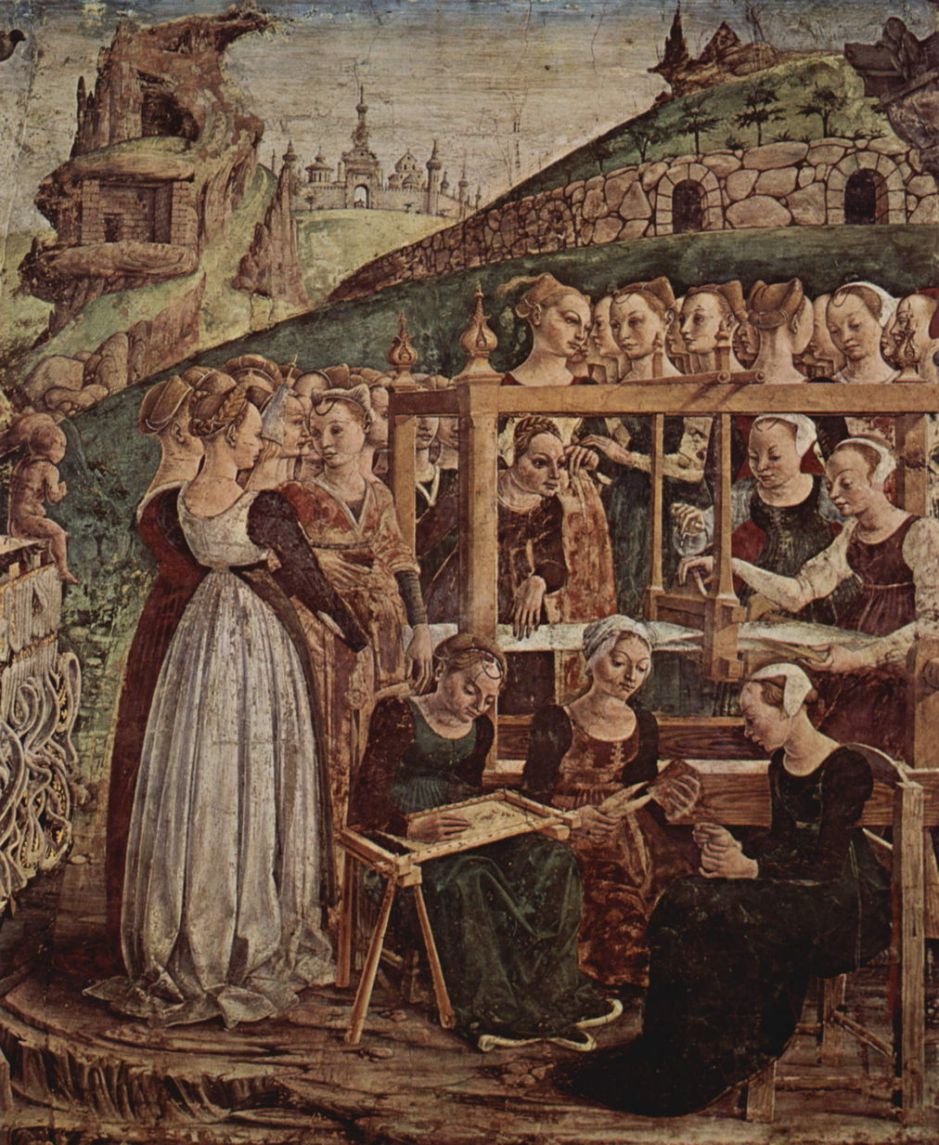
Several of the surviving paintings show Arachne and Minerva at their looms, weaving like fury. Francesco del Cossa’s The Triumph of Minerva (1467-70) was chosen for the month of March in his fresco for the Room of the Months in the Palazzo Schifanoia in Ferrara, Italy.
The trio of women in the foreground are engaged in allied crafts, including embroidery and sewing. Behind them are the two weavers working at what is shown as a single loom, the traditional boxwood shuttle just being inserted by the left hand of the woman at the right. They are surrounded by a large group of women spectators.
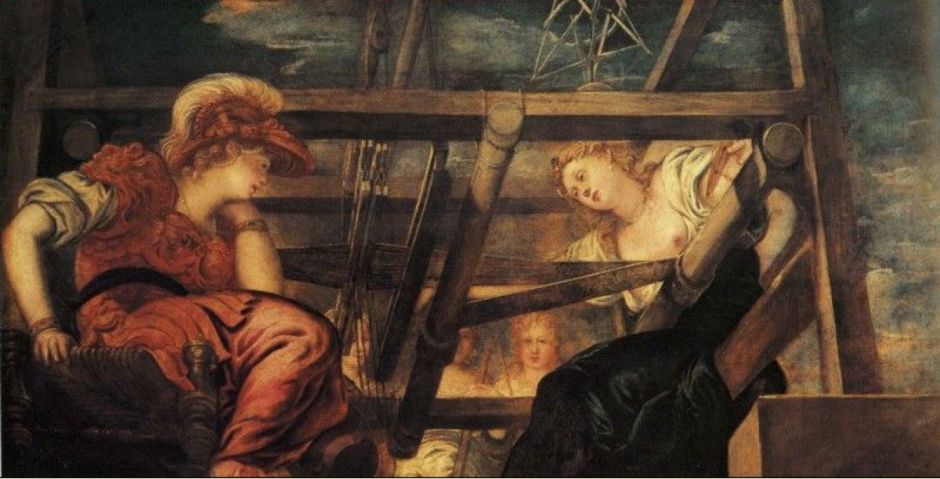
Tintoretto’s brilliant painting of Athena and Arachne (1543-44) shows the two from a highly innovative angle, which gives excellent (and fiendishly hard to project) views of both figures, including their faces. Minerva at the left wears her traditional plumed helmet, here made to look more like a woman’s hat than a warrior’s helmet. She also holds a sickle in her right hand.
Arachne is at the right with her robes tightened below the breasts, which are exposed, as Ovid described. Spectators are shown behind the loom, watching the contest in progress. Above Arachne’s head is a curious geometric construction which may have been used when preparing the wool after spinning.
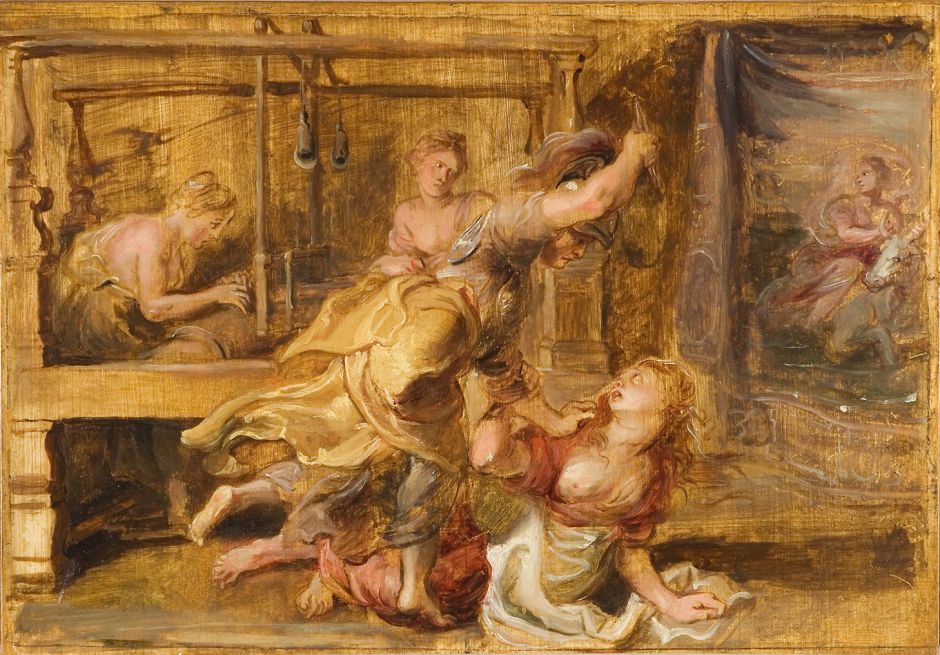
Rubens’ surviving oil study of Pallas and Arachne (1636-7) advances the story in a more conventional view. In the foreground, the angry Minerva is striking Arachne on the forehead with the shuttle.
To the right is one of the images woven by Arachne, showing Europa riding Jupiter disguised as a white bull, an image which Rubens was familiar with from Titian’s Rape of Europa (c 1560-62), copied so well by Rubens in 1628-29. However, the image shown here is quite different from either the original or its copy.
Behind Minerva and Arachne, two women are sat at a loom, and it is tempting to think that they too might represent the pair, in multiplex narrative. However, neither is dressed in red as is Arachne, leaving that question open. It is a great shame that Rubens’ finished painting has been lost.
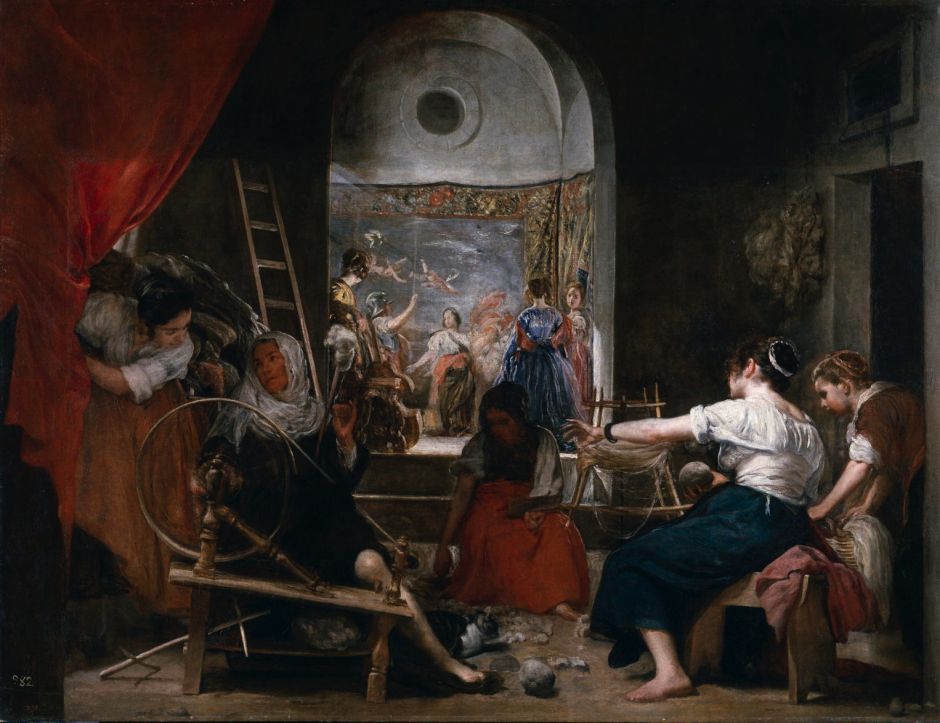
Since 1928, it has been claimed that Velázquez’ Las Hilanderas (The Spinners) (c 1657) should be read as showing the myth of Arachne. Overlooking for the moment the women spinning in the foreground, the brightly-lit background scene makes this appear plausible.
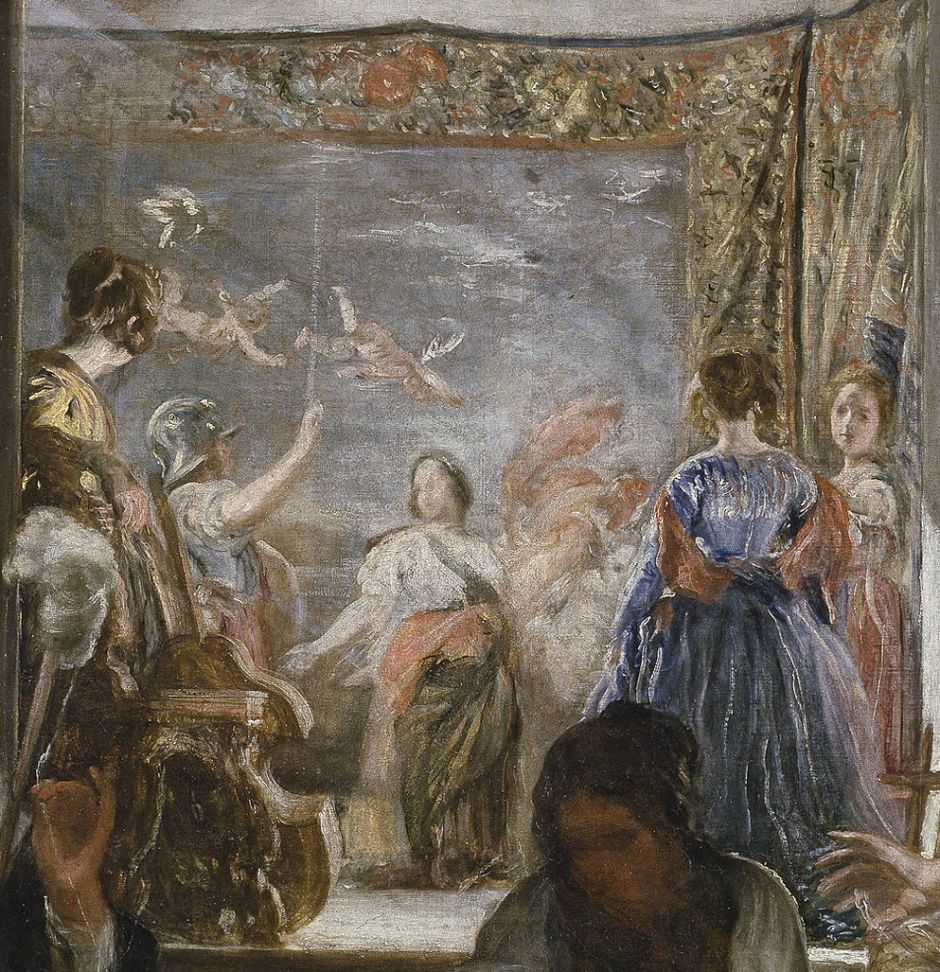
I have elsewhere explained in detail why I think that this is incorrect, largely on the fact that the five women in the foreground are not weaving at all, but spinning. The weaving being displayed, which is assumed to be a copy of the Titian or Rubens of the Rape of Europa is actually quite different too, and Rubens’ oil sketch above shows a version which is closer to those paintings.
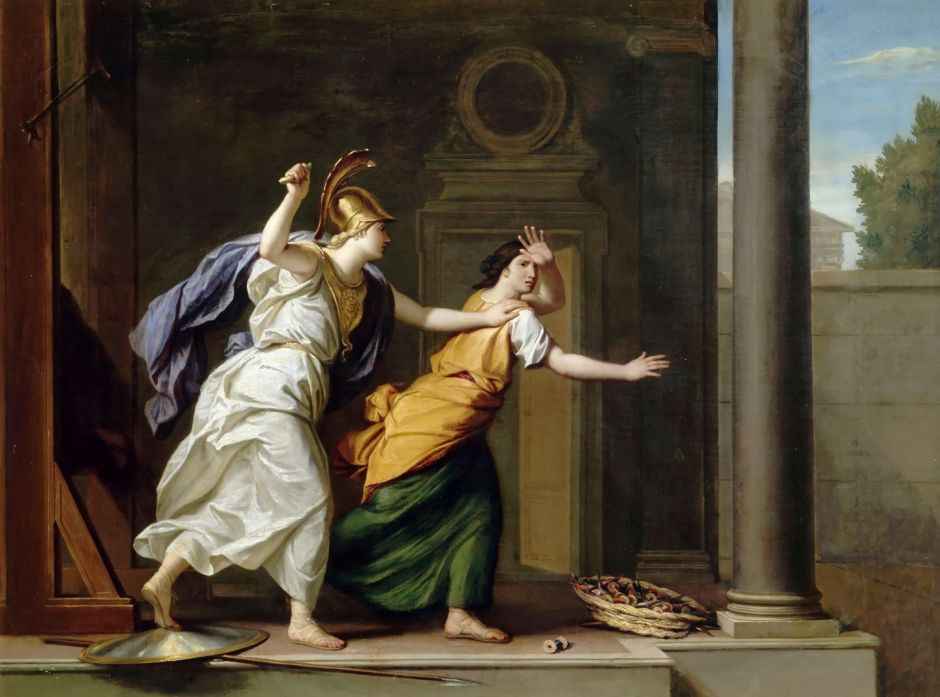
René-Antoine Houasse’s Minerva and Arachne (1706) also takes an advanced scene from the story, with Minerva about to strike Arachne with the shuttle. Although there is a basket of coloured wools suitable for weaving, just in front of Arachne’s feet, the looms and weavings are not shown.
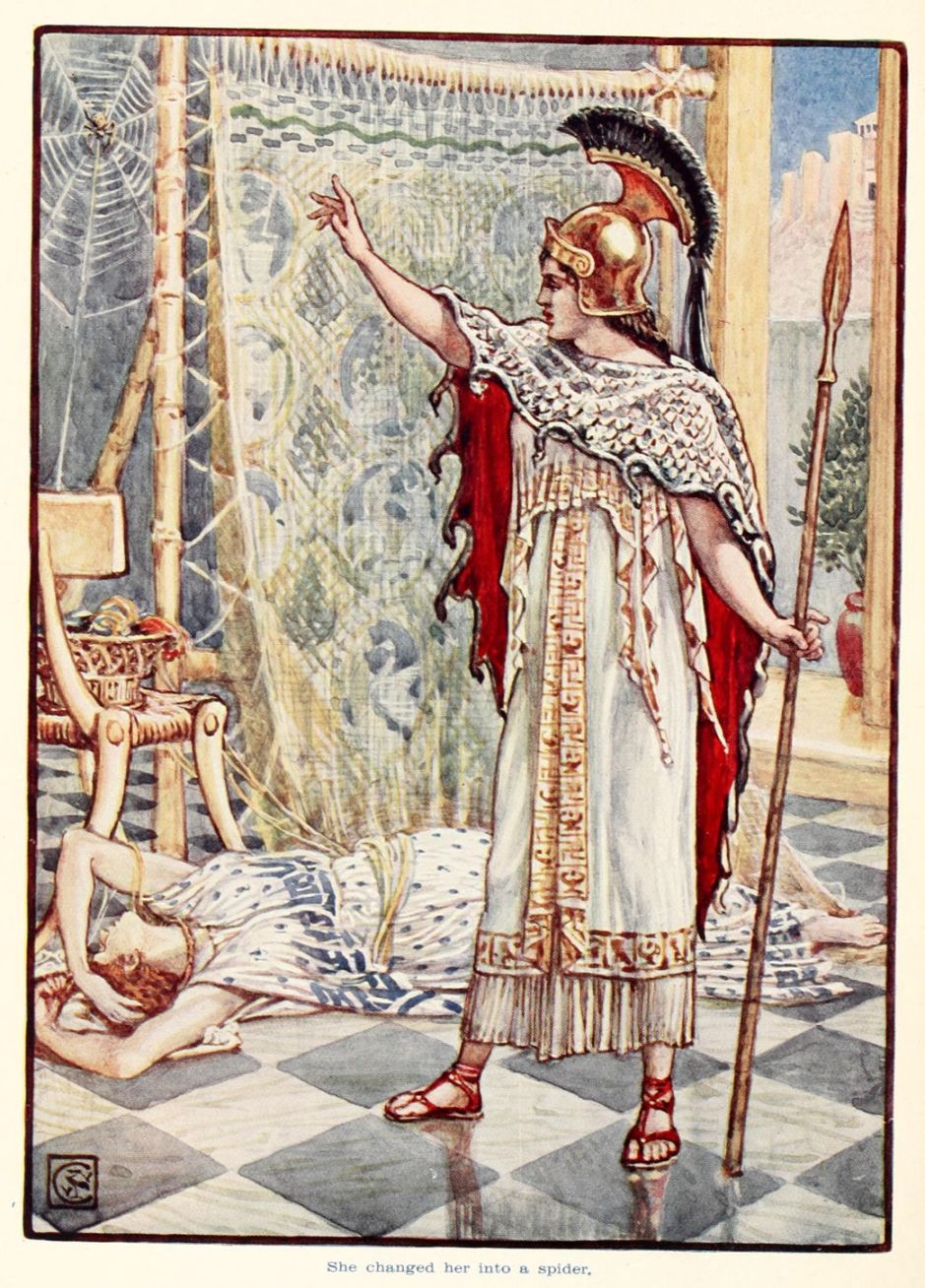
My final depiction is an illustration from late in Walter Crane’s career, used to illustrate children’s stories including this myth. Oddly for a children’s book, perhaps, Arachne is collapsed on the floor with a noose around her neck, and the weaving shown is decorative rather than artistic.
Both the Tintoretto and Rubens’ sketch are marvellous paintings. The former adopts such an unusual viewpoint, which must have been extremely hard to model and project properly, and for that it has my vote.
The English translation of Ovid above is taken from Ovid. Metamorphoses. Tr. Brookes More. Boston. Cornhill Publishing Co. 1922, at Perseus. I am very grateful to Perseus at Tufts for this.

